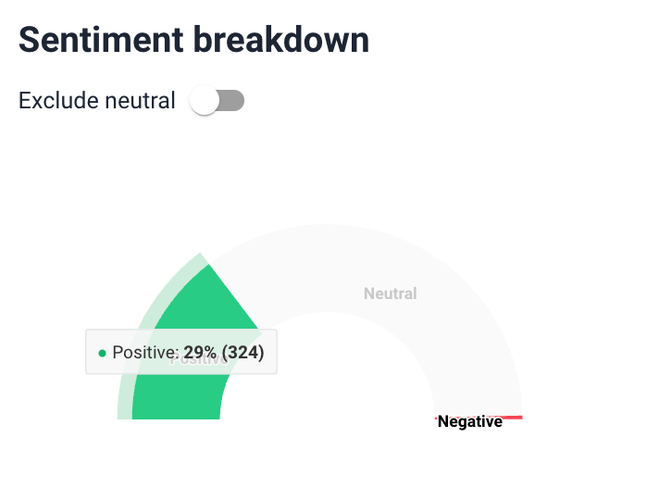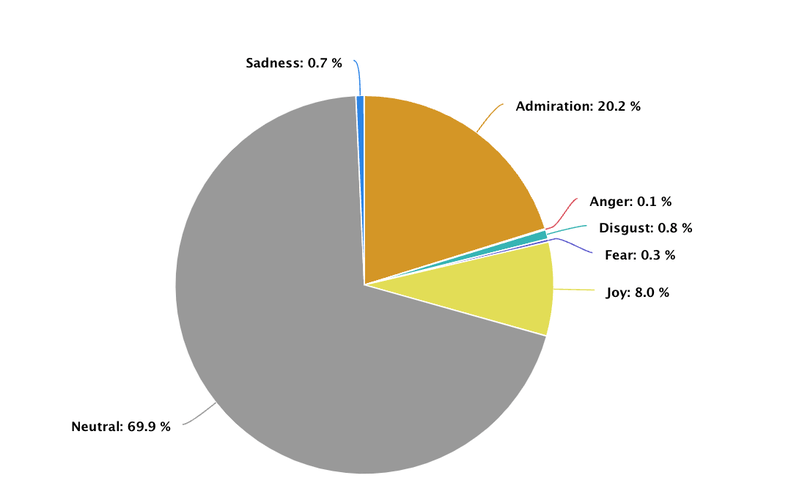How to Do Product Sentiment Analysis? Example & Guide
Table of contents
GoPro released its new GoPro Hero 13 in September. The outcome? Their product has received just 1% negative sentiment since launch and generated a reach of 27M. Impressive, right?
But where did that 1% come from? Forums. And here’s the thing: analyzing product sentiment matters. It helps improve customer satisfaction, addresses negative feedback, and gives insights for future improvements. Just like I know, the GoPro Hero 13’s most common complaint is battery life.
In this article, I’ll explain why product sentiment analysis is a game-changer & show you step-by-step how to do it effectively.
Let’s dive in!
Product sentiment analysis is the process of analyzing customer feedback to determine how people feel about a product. Their attitude can be positive, negative, or neutral.
It helps brands improve customer satisfaction, address problems early, and gain insights to improve their products and strategies. By understanding sentiment, you can connect better with your customers and grow your business more effectively.
What is product sentiment analysis?
Product sentiment analysis uses sentiment analysis algorithms to evaluate how people feel about a product based on textual data. Such data includes:
- Customer feedback
- Social media mentions
- Review sites
How does it work?
It’s all based on opinion mining. It’s a critical component of sentiment analysis that involves the automatic examination of text to discern sentiments behind customer feedback.
Sentiment analysis algorithms play a crucial role in the process of classifying sentiment.
It enables brands to automatically categorize mentions into:
- Positive

- Negative

- Neutral

& identify particular aspects of their products that customers either love or dislike.
This analysis often involves natural language processing and aspect-based sentiment analysis, which allows companies to focus on specific features, like durability or price.
For example, a comment like, “The GoPro’s video quality is amazing, but the battery life is disappointing,” is split into positive sentiment (video quality) and negative sentiment (battery life).
Why is sentiment analysis important?
- Gain a clearer picture of how customers feel about your brand.
- Identify areas for improvement.
- Identify negative feedback and improve customer satisfaction.
- Enhance company reputation – monitor brand sentiment and prevent potential crises.
So, sentiment analysis is critical for brands aiming to stay competitive and improve their customer experience.
How to do product sentiment analysis?
Performing sentiment analysis is simpler than you think, especially when using advanced sentiment analysis tools.
Why?
Analyzing sentiment often involves unstructured data from thousands of mentions.
Some companies do it using special surveys and than analyzing survey responses. But it’s time-consuming and misses a lot of publicly available data.
Machine learning-based sentiment analysis tools can automate the process and give you a full picture of your product’s sentiment.
How?
Sentiment analysis tools analyze mentions online and leverage natural language processing (NLP) to decode even complex human language and offer insights from many digital sources.
Of course, they do have some drawbacks. For example, they struggle to understand sarcasm and tend to identify it wrongly.
However, they still do a great job and make the process much easier and faster.
Take a look at GoPro – over a month, they collected 79,000 mentions with a total reach of 503M. These numbers are BIG!
And it doesn’t mean conducting a sentiment analysis for them is hard.
Let me show you!
Product sentiment analysis example
So, as you already know, conducting product sentiment analysis is best done using specialized media monitoring tools.
Let’s walk through the process step by step!
Sentiment analysis tools enhance traditional market research methods by automatically collecting data from various sources.
That’s why they provide a more comprehensive understanding of consumer perspectives.
Plus, they do the analysis for you, so you can skip to the hot part – gaining insights and improving your products.
I’ll show you exactly how I performed the product sentiment analysis for GoPro using Brand24, an AI-powered social listening tool.
Read on!
Step 1: Set up the monitoring project and collect customer feedback
The first step is to set up a social media monitoring project.
Brand24 allows you to monitor your brand name and any relevant keywords, hashtags, or phrases.
I generally tracked the brand name in GoPro’s case, so my keyword was “GoPro.” However, I wanted to focus on a specific product – GoPro Hero 13, so I filtered my results using this phrase:

Once the project is active, the tool collects data from various sources like social media platforms, blogs, forums, and review sites.
It’s essential to give the tool some time, usually a few days, to gather a sufficient number of mentions.
And it’s very important! Otherwise, the data might be irrelevant.
And here’s my favorite part: Brand24 allows you to filter mentions with incredible precision. You can filter by:
- Positive, neutral, or negative sentiment
- Intent
- Source (e.g., Instagram, TikTok, Facebook)
- Location
- Time frame
- Language
- & more!
This level of customization ensures you’re analyzing the most relevant data to your needs.

Step 2: Check the sentiment breakdown
Once you’ve gathered data, the next step is to analyze the sentiment breakdown. It’s simply creating a visual representation of positive sentiment, negative sentiment, and neutral mentions.
You can analyze sentiment in two ways:
- Manual overview
Simply check the sentiment chart to compare positive and negative feedback over time.
You’ll find it in the Brand24 dashboard after switching the “Mentions & Reach” chart to “Sentiment.”
Those two lines represent different sentiments. Green is for positive mentions, and red is for negative ones.
Plus, you can click on a specific day to check the exact number of positive and negative mentions.
It is valuable if you want to monitor sentiment trends and analyze them over time.
This is what it looks like for GoPro Hero 13:

- Sentiment breakdown
Use Brand24’s analysis to see the sentiment breakdown. You can find it in the Brand24 dashboard > Analysis > Sentiment breakdown.
You can check each sentiment percentage by clicking on it.
Here’s what it looks like for GoPro Hero 13 (in the last 30 days):
- Positive mentions: 324 (29%)
- Negative mentions: 7 (1%)
- Neutral mentions: 773 (70%)
Good job with your latest product, GoPro!
But what about so many neutral mentions? A significant percentage (70%) of mentions are neutral. Why?
Most of the posts are simply informative – they discuss the technical specifications or prices without any specific emotions behind them.

Doing this step of sentiment analysis helps:
- Identify overall sentiment trends
- Understand spikes in negative sentiment
- Determine where the positive sentiment is strongest
Step 3: Discover the exact emotions
Sentiment breakdown is just the tip of the iceberg.
Going deeper into the analysis, tools like Brand24 can help uncover the exact emotions customers associate with a product.
In Brand24, you can detect emotions such as:
- Admiration
- Anger
- Disgust
- Fear
- Joy
- Neutral
- Sadness
It’s a pretty wide range that lets you understand your audience sentiment even better and improve your market research.
The tool analyzes the data and presents it in two ways:
- The emotions share chart: It enables you to see which emotions dominate the discussions

- The emotions over time chart: Allows you to track emotional shifts throughout a campaign or product launch.

For GoPro Hero 13, emotions such as:
- Admiration and joy were predominant, reflecting excitement about GoPro’s video quality and usability.
- Anger or sadness occasionally appeared, mostly due to issues like battery life or technical glitches.
So, if GoPro wants to improve its Hero 13 – it could focus on the battery.
Monitoring emotion trends can give you customer insights that lead to customer needs-focused product improvements.
Step 4: Check the emojis
Emojis are more than just colorful icons and a fun touch-up.
They are powerful indicators of customer sentiment.
Analyzing emojis gives you a quick visual snapshot of how customers feel about your product. How?
People use emojis to express their emotions. We’d use a different emoji when talking about something that makes us sad and completely opposite when mentioning something we’re happy about.
For GoPro Hero 13, commonly used emojis include:
- ✅ (success or approval)
- 🤙 (casual approval, fun)
- 💖 (love or appreciation)
There are no negative emojis like 😡 (anger) or 😢 (sadness).
What can it mean?
The sentiment associated with GoPro is mostly positive, and it coincides with the general sentiment analysis.
So why bother with emoji analysis?
Emojis simplify the understanding of customer feedback and complement text data analysis.
Pro tip: They can also be a great way to communicate with your audience.
Perhaps doing the analysis you’ll find out your community uses something very specific – you could include that emoji in your message.
Emoji analysis might seem small, but it’s a fun way to dive deeper into customer feedback.
Give it a try!

Fun fact: The emojis in the Brand24 analysis are clickable! You can click on them to find all mentions that include them in one place.

Step 5: Dive into topics
Context is very important if we want to analyze product sentiment.
You should know your customer sentiment and what is important to them to fully understand what’s behind the sentiment.
So, how do I do it?
Sentiment analysis software like Brand24 is the answer.
Go to the Topic Analysis tab. It’s a tool that analyzes your mentions and categorizes them into the most important topics.
There’s also a sentiment analysis for a specific topic.
So, let’s take a closer look at the topic analysis for GoPro.
To get the results for a specific product – GoPro Hero 13, I added a filter:

These are the results I got:

Let’s take a look at the most important one – “Action Camera Equipment“:
- How many times has the topic been mentioned? 428
- How many people has the topic reached? 3.9M
- How important is it compared to other topics? 84.1%
- What’s the sentiment of this topic? 39% positive, 60% neutral, 1% negative
Good job GoPro!
Want to know even more? Let’s see what “more stats” offer!
It takes you to the entire new analysis tab, all about the specific topic you selected:

Step 6: Track the sentiment over time
Sentiment is dynamic!
It changes quickly due to social media posts that keep appearing, new viral reviews, or unexpected pr crises.
So, it’s very important to monitor your product sentiment regularly.
I suggest doing it at least once per month. However, the frequency will vary, and you need to adjust it.
Some of the reasons that will increase the optimal sentiment analysis frequency are:
- The volume of mentions you get
- New product releases
- New updates in your product
- Big sales
- PR crisis
I like to use the “Compare Periods” feature for that purpose. It briefly summarizes the changes between specific time frames.
Take a look this is the analysis for GoPro:

You’ll find it in the Brand24 dashboard > Comparison > Compare Periods.
Why should you constantly monitor the sentiment of a product?
- Identify spikes in negative sentiment and act fast.
- Measure the impact of product launches or campaigns.
- Monitor overall changes in brand sentiment.
Conclusion
Product sentiment analysis can bring lots of valuable insights. It enables you to determine whether you’re going in the right direction with your improvements.
Plus, it pinpoints the problems users have with your product.
You don’t monitor how your product is perceived? You lose the opportunity to be better.
Final thoughts:
- Monitoring your product sentiment helps you find weak spots, detect potential crises early, and protect your product reputation.
- If you get a lot of mentions – manual sentiment analysis is almost impossible (and definitely inefficient).
- Use AI sentiment analysis tools like Brand24. It will give you a full picture of how people feel about your product without extra hassle.
Want to improve your products? Start sentiment analysis with the Brand24 trial now!


